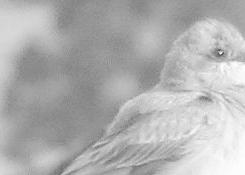- List of Species Observed in RioEmbudoBirds.org area (Updated 2023):
- All Seasons, All Species
- Species Present All Year
- Winter Visitors
- Spring-Fall Transients
- Migrant Summer Breeders
- Non-breeding Vagrants
- Observing Birds
- Local Bird Counts
- Bird Migration
- Bird Song and Sound
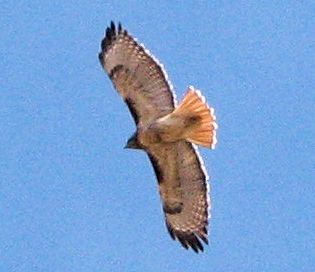 Red-tailed Hawk
Red-tailed Hawk El Bosque 2007.11.07 Red Tails Overhead.Along the Río Embudo it is common to see a Red-tailed Hawk (Buteo jamaicensis) soaring in the sky. Although we have Red-tailed Hawks all year, their numbers usually increase during the fall migration as birds from further north move south. Some of these migrants just pass through and continue south, but some remain all winter. The result is that Red-tailed sightings are generally more frequent in the winter than in the summer. Of course, if you let the cold weather keep you indoors in the winter, this may not be true for you. It is also common to see these hawks perched in trees along the river or up on the ridges above the arroyos. If you look closely, you will see a band of dark markings across the white chest of the bird. At a distance, however, the whole breast and belly may appear white. 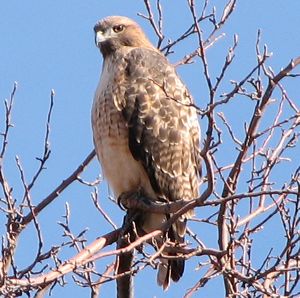 El Bosque 2007.11.08
El Bosque 2007.11.08
When the hawk is perched, you may not be able to see the red tail at all. But if you wait long enough, the bird will lift a wing to stretch or preen its feathers and show you its tail.  Red-tailed Hawk
Red-tailed Hawk El Bosque 2007.11.08 Sometimes you can be led to a perched hawk by other birds like Crows and Magpies. These species often work collectively to force a Red-tailed Hawk out of an area. The Crows in El Bosque were very busy in the fall of 2007 driving away the Red-tailed Hawk in these pictures. They do what is called "mobbing". As many as 20-30 Crows and Magpies may join together making mobbing calls and diving at the hawk. Eventually, the hawk will get tired of the harassment and take to the air. If you hear what sounds like an army of crows making a lot of noise, go investigate. You are likely to see a hawk or an owl being mobbed.
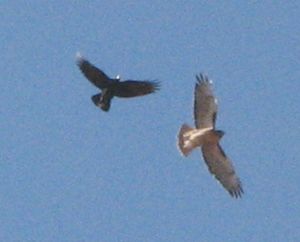
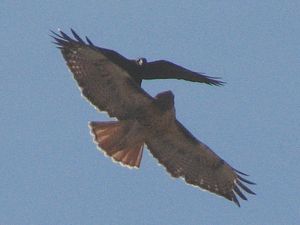
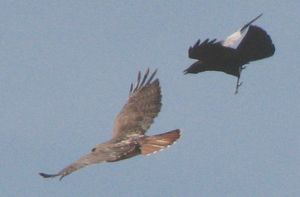
All about Red-tailed Hawks (at Cornell Lab of Ornithology) |
November 23, 2007:Here is a sequence of photos of an American Dipper (Cinclus mexicanus) feeding on the bottom of the Río Embudo: Free DHTML scripts provided by |
Eurasian InvasionThe Eurasian Collared-Dove Streptopelia decaocto was introduced in the Bahamas in the 1970s. Originally from Asia, it spread across Europe in the first half of the 20th century. Since its release in the Bahamas it has spread across most of the continental United States.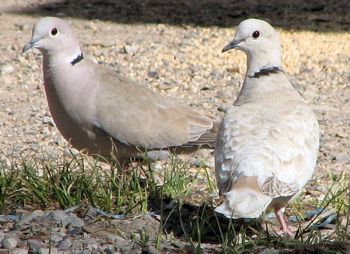 Photo: Peñasco, NM: April 19, 2007
Photo: Peñasco, NM: April 19, 2007
I first observed them in the Rio Embudo area on April 25, 2006 in Cachanillas, near Lyden. In the Fall of 2006 they were observed in Peñasco for the first time. They appear to have established themselves around a corral there and are observable on any day now. They were first recorded on the Dixon Christmas Bird Count in December of 2006 (4 Individuals). They were not recorded again until the Dixon CBC on December 14, 2009 when 19 individuals were observed. In the 2010 CBC, 44 individuals were recorded locally. In the 2011 CBC, the number grew to 56. This growth is seen nationally as well, with individuals now inhabiting the western two-thirds of the United States. (Click Here to see Range Map ) At first glance, they will probably be thought to be Pigeons or Mourning Doves, but if you look closely, they look quite different. Look for the black line on the back of the neck (nape). Here are links, so you can compare them with the more common Rock Pigeons and Mourning Doves. Rock Pigeon Columba liviaMourning Dove Zenaida macroura Eurasian Collared-Dove Streptopelia decaocto |
Spring arrival and nesting observations for 2008
|
Spring arrival and nesting observations for 2007The link above takes you to a list of arrivals of species and observations of behavior during the period of February 5, 2007 until May 16, 2007. |
Copyright 2006-2021 by Rio Embudo Birds.org --- All rights reserved.
